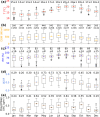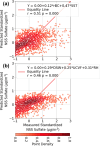Photochemical and Cloud and Aerosol Aqueous Contributions to Regionally-Emitted Shipping and Biogenic Non-Sea-Salt Sulfate Aerosol in Coastal California
- PMID: 40242281
- PMCID: PMC11997993
- DOI: 10.1021/acsestair.4c00352
Photochemical and Cloud and Aerosol Aqueous Contributions to Regionally-Emitted Shipping and Biogenic Non-Sea-Salt Sulfate Aerosol in Coastal California
Abstract
Aerosol nonsea-salt sulfate (NSS sulfate) forms in the atmosphere by secondary reactions of emissions from marine phytoplankton and shipping, with gas-phase as well as cloud and aerosol aqueous reactions controlling production. Twelve months of Atmospheric Radiation Measurements (ARM) during the Eastern Pacific Cloud Aerosol Precipitation Experiment (EPCAPE) at Scripps Pier in La Jolla, California, showed the highest NSS sulfate mass concentrations occurred for the northwesterly back-trajectories over 64% of the year, with an average of 0.90 μg/m3 that contributed 76% of annual NSS sulfate concentration. Multiple Linear Regression (MLR) and a refractory black carbon tracer method attributed 76-80% of the regionally emitted sulfur dioxide (SO2) sources of submicron NSS sulfate to marine biogenic emissions and 20-24% to shipping emissions. MLR for oxidation processes explained 21% of the variability with Downwelling Shortwave Radiation (DSW) driving photochemical reactions to account for 34% of annual regional sulfate production, Upwind Cloud Vertical Fraction (UCVF) controlling cloud-associated oxidation to account for 29%, and relative humidity (RH) describing aerosol-phase oxidation to account for 36%. NSS sulfate was correlated moderately to UCVF during April-June and August but to RH in October-January. These findings show the apportionment of SO2 emissions to biogenic and shipping sources and provide observational constraints for the mechanisms for sulfate production from SO2 in the atmosphere.
© 2025 The Authors. Published by American Chemical Society.
Conflict of interest statement
The authors declare no competing financial interest.
Figures











References
-
- Seinfeld J.; Pandis S.. Atmospheric Chemistry and Physics: From Air Pollution to Climate Change, 3rd ed.; John Wiley & Sons, 2016.
-
- Williams K. D.; Jones A.; Roberts D. L.; Senior C. A.; Woodage M. J. The Response of the Climate System to the Indirect Effects of Anthropogenic Sulfate Aerosol. Clim. Dyn. 2001, 17 (11), 845–856. 10.1007/s003820100150. - DOI
-
- Kristjánsson J. E.; Iversen T.; Kirkevåg A.; Seland Ø.; Debernard J. Response of the Climate System to Aerosol Direct and Indirect Forcing: Role of Cloud Feedbacks. J. Geophys. Res. Atmospheres 2005, 110 (D24), 2005JD006299.10.1029/2005JD006299. - DOI
-
- Fung K. M.; Heald C. L.; Kroll J. H.; Wang S.; Jo D. S.; Gettelman A.; Lu Z.; Liu X.; Zaveri R. A.; Apel E. C.; Blake D. R.; Jimenez J.-L.; Campuzano-Jost P.; Veres P. R.; Bates T. S.; Shilling J. E.; Zawadowicz M. Exploring Dimethyl Sulfide (DMS) Oxidation and Implications for Global Aerosol Radiative Forcing. Atmospheric Chem. Phys. 2022, 22 (2), 1549–1573. 10.5194/acp-22-1549-2022. - DOI
LinkOut - more resources
Full Text Sources
Miscellaneous
